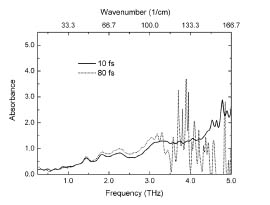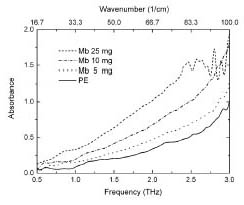Katsuhiro Ajito1, Rakchanok Rungsawang1, Yuko Ueno2, and Isao Tomita3
1Materials Science Laboratory,
2NTT Microsystem Integration Laboratories, 3NTT Photonics Laboratories
Terahertz (THz, 1012 Hz) spectroscopy is used in the field of biological molecule analysis.
This is because information on weak inter- and intra-molecular interactions
can be obtained as low frequency vibration modes in the THz range. We showed
that THz time-domain spectroscopy (THz-TDS) using THz wave pulses has a
wide spectral range and exhibits sufficient sensitivity to molecules to
be used as a tool in analytical chemistry. Furthermore, we successfully
characterized amino acids using the low frequency vibration modes that
appear in THz spectra.
Figure 1 shows the pulse width dependence of the THz absorption spectra
of tryptophan, an essential amino acid, pumped by ultra-short pulse lasers.
Since a mode-locked Ti:sapphire laser is usually used to pump photoconductive
dipole antennas for emitting and detecting THz electromagnetic pulses in
a THz-TDS system, the upper limit of the spectral range is related to the
pulse width of the pump laser. The use of ultrashort pulse lasers with
pulse widths of 10 femtoseconds (fs) or less enables us to measure the
spectral region expanded up to 5 THz and obtain more molecular information.
Furthermore, we showed that THz spectroscopy is advantageous for determining
molecular orientation and molecular interaction by employing the angle
dependent THz-TDS spectroscopy of amino acid single crystals [1].
Moreover, when dried myoglobin was measured as a typical protein, there
was an absorption increase in the THz range corresponding to the myoglobin
concentration as shown in Fig. 2 [2]. We can expect to acquire information
about the hydrogen bonds related to the high order structure of proteins
by controlling the protein water content. Moreover, further development
of a semiconductor THz-wave source employing difference frequency generation
[3] will be applied to the analysis of single biological molecules and
imaging measurement.
[1] R. Rungsawang, K. Ajito, Y. Ueno, I. Tomita, Extended Abstracts: International Workshop on Terahertz Technology, Nov. 16-18, 199-200, 2005
[2] R. Rungsawang, Y. Ueno, H. Takenouchi, I. Tomita, K. Ajito, Proceedings of IRMMW-THz2005, Sep 19-23, Williamsburg (2005) 211-212.
[3] I. Tomita, H. Suzuki, H. Ito, H. Takenouchi, K. Ajito, R. Rungsawang,
and Y. Ueno, Appl. Phys. Lett. 88 (2006) 071118.
 |
 |
|||||
|
|